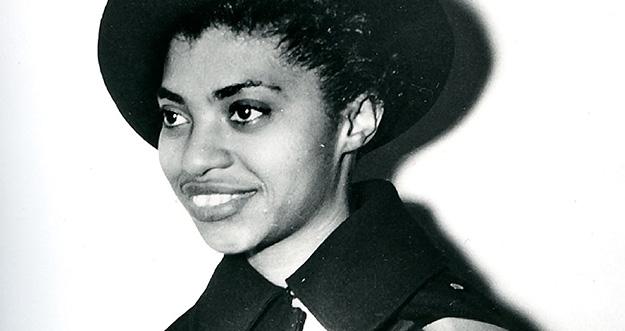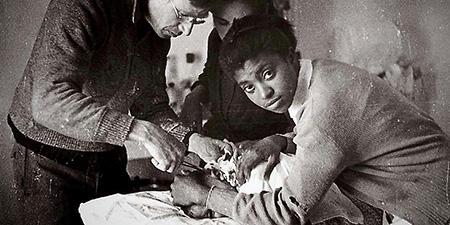Salaria Kea: Nurse and freedom fighter

Catholic, Internationalist, Memoirist, Organizer, Nurse, Salaria Kea was born on July 13, 1917 (1913 in one account), in Milledgeville, the Georgia State capital throughout the Civil War, where slave auctions took place in the Capital Square. By 1917, the bowed backs of sharecroppers and prison laborers had replaced the bent backs of slaves in the vast fields of cotton surrounding Milledgeville. These images were undoubtedly seared in young Salaria’s mind, a reminder of the invisible barricades of race and of man’s brutality to man, making her extraordinary achievements as a nurse all the more remarkable. She fought fascism on the frontlines of Spain and racial barriers in New York’s Harlem Hospital and in the U.S. Army successfully.
From Akron to New York City
By most accounts, Salaria was raised by four brothers and family friends in Akron, Ohio; the whereabouts of her parents is unclear. Whatever the circumstances, Salaria’s memories of life in Akron were positive. There her early ambitions to become a nurse took hold. Even so, Salaria must have been acutely aware of the obstacles in front of her.
Racial tensions were high in Akron in the first decades of the 20th century, exacerbated by the arrival of Eastern European immigrants. According to Philosopher Shirla Robinson McClain, “By the early 1920s racial barriers had been erected to the extent that blacks 1) were not served in Akron’s finer restaurants; 2) were requested to sit in the balcony in theaters; 3) could not swim in local swimming pools; 4) were refused lodging in the city’s hotels; and 5) were “invisible” in both managerial business positions and in administrative posts in the local government.” On March 1, 1915, Cleveland Clinic Akron General Hospital opened. Muriel L. Walker, the first black nurse to work there, joined the staff in 1948.
Around 1930, Salaria moved to New York City, but felt herself to be an outsider. Salaria told an interviewer: “In New York [it was] just like you were in a foreign country, if you came from Akron, because everybody had their own language.”
Undaunted, she enrolled in Harlem Hospital School of Nursing, the second training school for African American nurses to open in the City. The Lincoln School of Nursing (Bronx 1898), a private institution, was first — in New York and in the United States, but Harlem Hospital was the first municipal institution to embrace “the ideal of integration.”
Desegregating NYC municipal hospitals
Adam Biggs, African American Studies Professor, University of South Carolina Lancaster, wrote: “Black civic activists had been advocating to desegregate New York’s municipal hospital system since the early 1910s. But black practitioners would not gain entrance until the nation’s wartime effort placed a burden on medical staffing that could not be ignored. With a reluctant city administration, a small number of practitioners began acquiring low-level positions as early as 1917, and in August 1919, Louis T. Wright became the first black doctor to join the Harlem Hospital staff. Continued advocacy over the next decade pushed the hospital to gradually incorporate black physicians and nurses into its ranks.
“…Shortly after their appointments, the hospital saw a mass exodus of white practitioners who transferred or resigned in protest. Many of those remaining displayed their discontent by acting with belligerence or passive aggression toward the new black hires. Tensions reached a peak in 1927 when a hospital riot was barely averted after a junior white intern, dining in the cafeteria, threw water in the face of Aubré Maynard, a senior resident at the time.”
On the frontlines
In the early 1930s, Salaria Kea, a nursing student endowed with an iron will, unflappable determination, and enduring courage, would participate in the campaign to integrate finally and successfully the hospital’s staff dining room. Later, she would draw a parallel in her memoirs (Salaria wrote four) between the nurses she encountered at Harlem Hospital and the Spanish peasants she met on the frontlines of the Spanish Civil War:
“The Spanish peasants had been psychologically just as imprisoned, had accepted the belief that nothing could be done about their situation as had the Harlem nurses earlier accepted racial discrimination in their dining room. Like the Harlem nurses, too, the peasants were now learning that something could be done about it….There was nothing inviolable about the old prejudices…they could be changed and justice established.”
Salaria graduated from nursing school in 1934, and went to work at Staten Island’s Seaview Hospital, the largest facility at the time for the treatment of tuberculosis in the United States. It was, according to Asylum Projects, “the first tuberculosis hospital to have a maternity ward and led the country in the treatment and caring of TB patients. Research at the hospital would help end the tuberculosis epidemic.” Salaria was promoted eventually to Seaview’s head nurse.
During this time, Salaria Kea applied and was turned down by the Emperor Haile Selassie for work in Ethiopia and by the American Red Cross (ARC) to help flood victims in the Midwest. There is reason to believe that Salaria was denied work with the Red Cross because of her race, although in 1918 Frances Reed Elliot became the first African American nurse to be admitted to that organization, an achievement that would not shield Elliot from discrimination inside its ranks.
By March 1937, Salaria appears to have been radicalized by the American left. She joined the American Medical Bureau working with the Abraham Lincoln Brigade in the Spanish Civil War. Salaria was the only African American nurse and one of only a few African American women to serve in the Brigade. She and the second American Medical Unit set up the first American base hospital at Villa Paz in Spain.
According to her memoir Health and Medicine, “The beds of Villa Paz were soon filled with soldiers of every degree of injury and ailment, every known race and tongue from every corner of the earth. These divisions of race, creed and nationality lost significance when they met in a united effort to make Spain the tomb of Fascism. I saw my fate, the fate of the Negro race, was inseparably tied up with their fate: the efforts of the Negroes must be allied with those of others as the only insurance against an uncertain future.”
Desegregation at hospitals
Historians and fellow volunteers have been unable to document aspects of Salaria’s time in Spain. She claimed to have been taken prisoner — for weeks in some accounts, in others days. This has been disputed. But certain facts are irrefutable.
Salaria Kea met and married her husband in Spain: John Patrick O’Reilly, a member of the Irish American Brigade. She moved from unit to unit — Aragon, Lerida, Barcelona. Injured by a bomb, she recuperated in France. In May of 1938, she returned to the United States. More than two years would pass before O’Reilly could join her, in part a function of their interracial union.
According to Emily Robins Sharpe, ”Once back in the United States — and especially in Akron — she and O’Reilly experienced extensive racism in the form of personal threats and property damage: according to various interviews, at certain points they were afraid to leave the house together.”
In 1944, Salaria Kea went on to serve in World War II, when African-American women were first recruited. She coordinated desegregation campaigns in several hospitals after the war, and retired to Akron with her husband in 1973.
If little had changed in the cotton fields of Georgia by the time of her retirement — 492 African Americans were lynched between 1862 and 1968; not one African American would hold a seat from 1907 to 1962 in the Georgia State Assembly, the indomitable spirit of Salaria Kea had long since buried the chains she inherited as a native daughter, and dedicated her life to freedom and democracy for all people. She died on May 18, 1990, having fought the good fight with undeniable courage and dedication.
